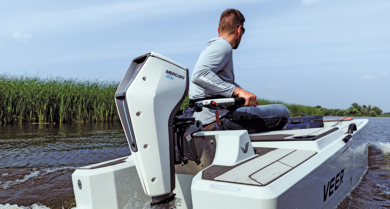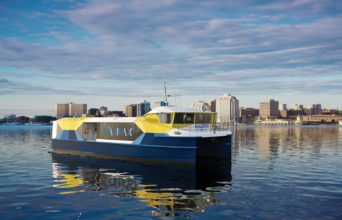The benefits and challenges of electric propulsion for recreational boats

By Maciej Rynkiewicz
Assistant Standards Developer, ABYC
Electric propulsion systems are making waves in the world of recreational boating. As technology evolves, these systems bring plenty of perks compared to traditional internal combustion engines.
At the same time, they also come with their own set of challenges. Let’s dive into the benefits and hurdles of electric propulsion for recreational boats, giving boating enthusiasts and industry folks a clear picture of what’s on the horizon.
Environmental consideration
Electric propulsion can be a significant win for the environment. It doesn’t produce emissions while running, which helps to keep marine ecosystems clean and reduces your boating carbon footprint. However, the lack of emissions while the boat runs is only one part of the boat’s overall environmental impact. It’s crucial to consider how the energy used to recharge your electric boat is produced—whether that energy comes from renewable sources or fossil fuels. Additionally, the sustainability of battery manufacturing and the recyclability of the batteries are important factors. These and many other considerations will influence the final rating on the eco-friendly scale.
Electric propulsion simplifies the integration of renewable energy by allowing electric boats to be recharged using solar panels or wind turbines. This reduces reliance on fossil fuels, making boating more sustainable.
It’s also essential to recognize that electric propulsion is not a one-size-fits-all solution to environmental concerns. There are other ways to reduce the environmental impact of recreational boats. Internal combustion engines powered by renewable liquid fuels or hydrogen propulsion systems are also viable options for decarbonizing recreational boating.
Electric boats are significantly quieter than those with combustion engines, reducing noise pollution and enhancing your boating experience. Whether you’re fishing, watching wildlife, or simply cruising, the silent operation of an electric boat makes the experience more enjoyable for both the user and people onshore.
Performance
Current battery technology may not match the energy density of fossil fuels, but electric motors are remarkably efficient. They convert nearly 90% of electrical energy into mechanical energy. In contrast, even the most advanced internal combustion engines achieve peak efficiency of only 20-40%, with significant energy losses primarily due to friction (heat). The laws of thermodynamics fundamentally limits the efficiency of all combustion engines, leaving little room for improvement.
Instant torque is a hallmark feature of electric motors. Unlike combustion engines that require revving up to reach peak power and torque, electric motors deliver maximum rotational force from the moment they start spinning. This means they can provide full torque immediately. This immediate torque delivery is one of the key advantages of electric boats, making them quicker off the mark and more agile compared to traditional combustion-powered vessels.
Maintenance
One of the great advantages of electric propulsion systems is their simplicity. With fewer moving parts, there is less that can go wrong. You won’t have to deal with oil changes or replacing fuel filters anymore. That means fewer headaches and lower maintenance costs. Instead of maintaining the engine, you’ll have more time to enjoy cruising on the water. Electric power makes boating smoother and more carefree, so you can focus on the fun parts of being out on your boat.
Range, refueling and charging infrastructure
One of the significant drawbacks of electric propulsion is its limited range. Current battery technology doesn’t match the energy density of fossil fuels, so electric boats typically can’t travel as far on a single charge. This limitation can be a deal-breaker for long-distance cruising or activities that keep you on the water for extended periods without refueling. However, this drawback can be mitigated with the potential for onboard power generation, including renewable sources.
It’s worth noting that since lithium-ion batteries debuted commercially three decades ago, battery technology has continued to evolve. While most significant improvements have occurred on the lithium-metal-oxide cathode side, graphite anodes have largely remained unchanged. Now, a promising new anode technology is on the horizon. Silicon has long been considered a viable medium for anodes because it can hold ten times as many lithium ions by weight as graphite. If this translates into improved battery energy density, it could be a game-changer for electric propulsion, akin to the transition from lead-acid to lithium-ion batteries. After several years of research and incremental improvements, silicon-anode technology finally appears ready for commercial implementation.
Recharging batteries takes longer than filling up a gas or diesel tank. While fast-charging technology is improving, it still can’t compete with the convenience of quickly refueling at a pump. This can be inconvenient for boaters who need to get back on the water quickly, especially if charging stations are sparse.
There is still significant room for improvement in charging infrastructure and the availability of fast charging stations. Not all boaters, however, will require access to fast charging, as many will be satisfied with overnight charging from traditional shore power. However, marinas’ electrical infrastructure may not yet be equipped to handle large fleets of electric boats.
Efforts to expand the charging infrastructure for electric boats are already underway. Marinas and docking facilities are starting to install charging stations, and mobile charging solutions are being developed. As the network grows, the convenience and practicality of electric boating will improve, encouraging more boaters to make the switch.
Standards and regulations
Electric propulsion systems are an increasingly important part of the recreational marine industry. Ensuring the safety of boats is a key reason why ABYC, established over 70 years ago, is actively involved in creating standards that promote boating safety through proper design, construction and installation of boat systems, including electric propulsion systems.
Standard E-30, Electric Propulsion, specifically addresses systems over 60 V DC, while low voltage systems must comply with the E-11 standard. US experts are also actively engaged in the development of ISO 16315 to harmonize boatbuilding requirements globally.
A significant challenge is the lack of proper standards for installing charging stations in marinas. This area is typically governed by NFPA 70, National Electrical Code. We anticipate that the 2026 review of this document will provide relevant guidance for the installation of boat-charging stations.
We continuously monitor regulatory activities both in the United States and globally. Additionally, we are developing a document that will address the unique challenges of charging boat batteries from shore-based charging stations, including communication, ground fault protection and integration with other onboard systems.
Wrapping it up
Electric propulsion for recreational boats offers numerous advantages, including being environmentally friendly, quiet, efficient and low-maintenance. These benefits make electric boats an appealing choice for eco-conscious and technology-savvy boating enthusiasts. However, challenges such as limited range, high initial costs and the current scarcity of charging stations present significant hurdles.
As battery technology advances and charging infrastructure expands, electric boats have opportunity to become a more viable and attractive option for recreational boating. With ongoing innovations and improvements, electric propulsion systems are set to play a significant role in the evolution of the recreational marine industry.
Maciej Rynkiewicz is the Assistant Standards Developer at the American Boat & Yacht Council.




